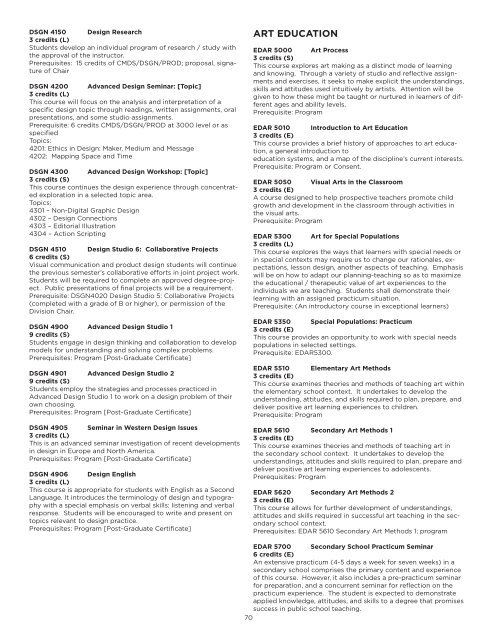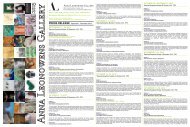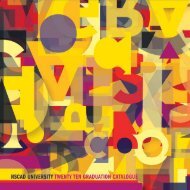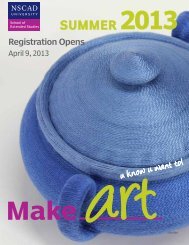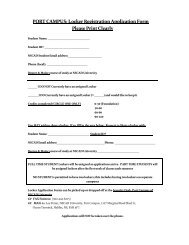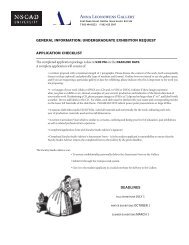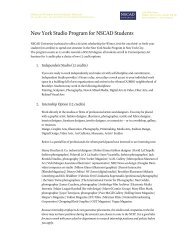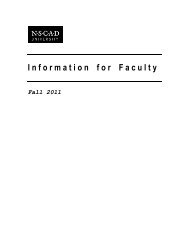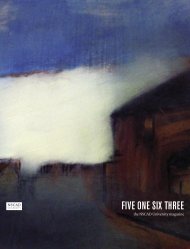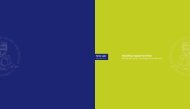CONTENTS - Nova Scotia College of Art and Design
CONTENTS - Nova Scotia College of Art and Design
CONTENTS - Nova Scotia College of Art and Design
You also want an ePaper? Increase the reach of your titles
YUMPU automatically turns print PDFs into web optimized ePapers that Google loves.
DSGN 4150 <strong>Design</strong> Research<br />
3 credits (L)<br />
Students develop an individual program <strong>of</strong> research / study with<br />
the approval <strong>of</strong> the instructor.<br />
Prerequisites: 15 credits <strong>of</strong> CMDS/DSGN/PROD; proposal, signature<br />
<strong>of</strong> Chair<br />
DSGN 4200 Advanced <strong>Design</strong> Seminar: [Topic]<br />
3 credits (L)<br />
This course will focus on the analysis <strong>and</strong> interpretation <strong>of</strong> a<br />
specific design topic through readings, written assignments, oral<br />
presentations, <strong>and</strong> some studio assignments.<br />
Prerequisite: 6 credits CMDS/DSGN/PROD at 3000 level or as<br />
specified<br />
Topics:<br />
4201: Ethics in <strong>Design</strong>: Maker, Medium <strong>and</strong> Message<br />
4202: Mapping Space <strong>and</strong> Time<br />
DSGN 4300 Advanced <strong>Design</strong> Workshop: [Topic]<br />
3 credits (S)<br />
This course continues the design experience through concentrated<br />
exploration in a selected topic area.<br />
Topics:<br />
4301 – Non-Digital Graphic <strong>Design</strong><br />
4302 – <strong>Design</strong> Connections<br />
4303 – Editorial Illustration<br />
4304 – Action Scripting<br />
DSGN 4510 <strong>Design</strong> Studio 6: Collaborative Projects<br />
6 credits (S)<br />
Visual communication <strong>and</strong> product design students will continue<br />
the previous semester’s collaborative efforts in joint project work.<br />
Students will be required to complete an approved degree-project.<br />
Public presentations <strong>of</strong> final projects will be a requirement.<br />
Prerequisite: DSGN4020 <strong>Design</strong> Studio 5: Collaborative Projects<br />
(completed with a grade <strong>of</strong> B or higher), or permission <strong>of</strong> the<br />
Division Chair.<br />
DSGN 4900 Advanced <strong>Design</strong> Studio 1<br />
9 credits (S)<br />
Students engage in design thinking <strong>and</strong> collaboration to develop<br />
models for underst<strong>and</strong>ing <strong>and</strong> solving complex problems.<br />
Prerequisites: Program [Post-Graduate Certificate]<br />
DSGN 4901 Advanced <strong>Design</strong> Studio 2<br />
9 credits (S)<br />
Students employ the strategies <strong>and</strong> processes practiced in<br />
Advanced <strong>Design</strong> Studio 1 to work on a design problem <strong>of</strong> their<br />
own choosing.<br />
Prerequisites: Program [Post-Graduate Certificate]<br />
DSGN 4905 Seminar in Western <strong>Design</strong> Issues<br />
3 credits (L)<br />
This is an advanced seminar investigation <strong>of</strong> recent developments<br />
in design in Europe <strong>and</strong> North America.<br />
Prerequisites: Program [Post-Graduate Certificate]<br />
DSGN 4906 <strong>Design</strong> English<br />
3 credits (L)<br />
This course is appropriate for students with English as a Second<br />
Language. It introduces the terminology <strong>of</strong> design <strong>and</strong> typography<br />
with a special emphasis on verbal skills: listening <strong>and</strong> verbal<br />
response. Students will be encouraged to write <strong>and</strong> present on<br />
topics relevant to design practice.<br />
Prerequisites: Program [Post-Graduate Certificate]<br />
ART EDUCATION<br />
EDAR 5000 <strong>Art</strong> Process<br />
3 credits (S)<br />
This course explores art making as a distinct mode <strong>of</strong> learning<br />
<strong>and</strong> knowing. Through a variety <strong>of</strong> studio <strong>and</strong> reflective assignments<br />
<strong>and</strong> exercises, it seeks to make explicit the underst<strong>and</strong>ings,<br />
skills <strong>and</strong> attitudes used intuitively by artists. Attention will be<br />
given to how these might be taught or nurtured in learners <strong>of</strong> different<br />
ages <strong>and</strong> ability levels.<br />
Prerequisite: Program<br />
EDAR 5010 Introduction to <strong>Art</strong> Education<br />
3 credits (E)<br />
This course provides a brief history <strong>of</strong> approaches to art education,<br />
a general introduction to<br />
education systems, <strong>and</strong> a map <strong>of</strong> the discipline’s current interests.<br />
Prerequisite: Program or Consent.<br />
EDAR 5050 Visual <strong>Art</strong>s in the Classroom<br />
3 credits (E)<br />
A course designed to help prospective teachers promote child<br />
growth <strong>and</strong> development in the classroom through activities in<br />
the visual arts.<br />
Prerequisite: Program<br />
EDAR 5300 <strong>Art</strong> for Special Populations<br />
3 credits (L)<br />
This course explores the ways that learners with special needs or<br />
in special contexts may require us to change our rationales, expectations,<br />
lesson design, another aspects <strong>of</strong> teaching. Emphasis<br />
will be on how to adapt our planning-teaching so as to maximize<br />
the educational / therapeutic value <strong>of</strong> art experiences to the<br />
individuals we are teaching. Students shall demonstrate their<br />
learning with an assigned practicum situation.<br />
Prerequisite: (An introductory course in exceptional learners)<br />
EDAR 5350 Special Populations: Practicum<br />
3 credits (E)<br />
This course provides an opportunity to work with special needs<br />
populations in selected settings.<br />
Prerequisite: EDAR5300.<br />
EDAR 5510 Elementary <strong>Art</strong> Methods<br />
3 credits (E)<br />
This course examines theories <strong>and</strong> methods <strong>of</strong> teaching art within<br />
the elementary school context. It undertakes to develop the<br />
underst<strong>and</strong>ing, attitudes, <strong>and</strong> skills required to plan, prepare, <strong>and</strong><br />
deliver positive art learning experiences to children.<br />
Prerequisite: Program<br />
EDAR 5610 Secondary <strong>Art</strong> Methods 1<br />
3 credits (E)<br />
This course examines theories <strong>and</strong> methods <strong>of</strong> teaching art in<br />
the secondary school context. It undertakes to develop the<br />
underst<strong>and</strong>ings, attitudes <strong>and</strong> skills required to plan, prepare <strong>and</strong><br />
deliver positive art learning experiences to adolescents.<br />
Prerequisites: Program<br />
EDAR 5620 Secondary <strong>Art</strong> Methods 2<br />
3 credits (E)<br />
This course allows for further development <strong>of</strong> underst<strong>and</strong>ings,<br />
attitudes <strong>and</strong> skills required in successful art teaching in the secondary<br />
school context.<br />
Prerequisites: EDAR 5610 Secondary <strong>Art</strong> Methods 1; program<br />
EDAR 5700 Secondary School Practicum Seminar<br />
6 credits (E)<br />
An extensive practicum (4-5 days a week for seven weeks) in a<br />
secondary school comprises the primary content <strong>and</strong> experience<br />
<strong>of</strong> this course. However, it also includes a pre-practicum seminar<br />
for preparation, <strong>and</strong> a concurrent seminar for reflection on the<br />
practicum experience. The student is expected to demonstrate<br />
applied knowledge, attitudes, <strong>and</strong> skills to a degree that promises<br />
success in public school teaching.<br />
70


